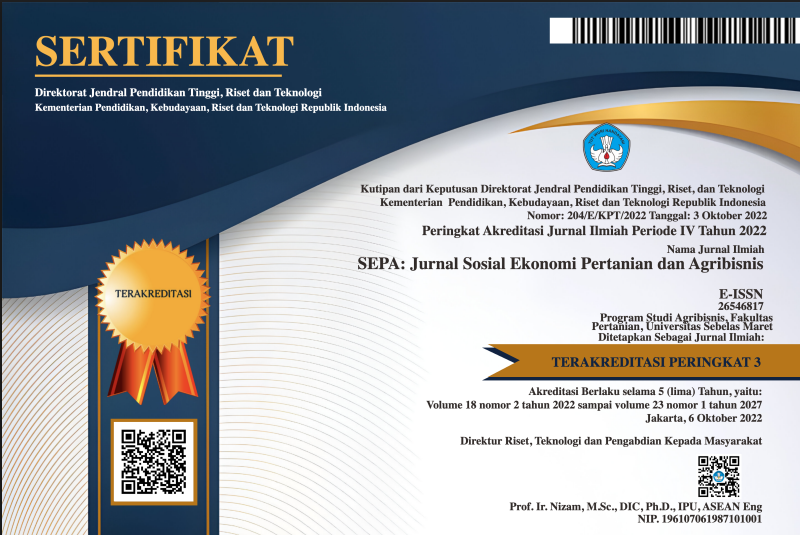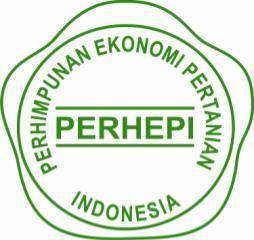KINERJA DAN EFISIENSI RANTAI PASOK (SUPPLY CHAIN) NANAS DI DESA TANGKIT BARU KECAMATAN SUNGAI GELAM KABUPATEN MUARO JAMBI
Abstract
This study aimed to analyze the pineapple supply chain's performance and efficiency in Tangkit Baru Village, Sungai Gelam District, Muaro Jambi Regency. The data used in the study was primary data, obtained from direct interviews using questionnaires to 76 respondents consisting of 56 farmers, and 20 marketing agencies involved in pineapple marketing in Tangkit Baru Village from October to December 2019. Pineapple supply chain performance is measured based on marketing efficiency using marketing margin criteria, farmer's share, and profit-to-cost marketing ratio. The results showed that there are five pineapple marketing channels in Tangkit Baru Village that involve marketing actors ranging from farmers, large inter-city traders, village collectors, out-of-pick-up merchants, retailers and consumers. Based on the analysis of marketing efficiency, the marketing channel that has the smallest total margin distribution, the largest farmer share is 100 percent and the total profit-to-cost ratio of 32.2 percent is the 5 marketing channel, so channel 5 is the most efficient marketing channel.
Keywords
Full Text:
PDFReferences
Ardila, D. D., Agustina, T., Subekti, S. (2019). Saluran dan margin pemasaran Kopi Cap Lereng Tancak Kabupaten Bondowoso. SEPA: Jurnal Sosial Ekonomi Pertanian Dan Agribisnis, 15(2), 116–127. https://doi.org/10.20961/sepa.v15i2.27430.
Dilana. (2013). Pemasaran dan Nilai Tambah Kakao. Prosiding Simposium Nasional Ekonomi Kakao. Retrieved from http://repository.ipb.ac.id/handle/123456789/69315.
Drajat, B., Agustian, A., & Supriatna, A. (2007). Export and competitiveness of Indonesian coffee bean in international market: Strategic implication for the development of organic coffee bean. Pelita Perkebunan (a Coffee and Cocoa Research Journal), 23(2). https://doi. org/10.22302/iccri.jur.pelitaperkebunan.v23i2.88
Lambert, D. M., & Enz, M. G. (2017). Issues in supply chain management: Progress and potential. Industrial Marketing Management, 62, 1–16. https://doi.org/ 10.1016/j.indmarman.2016.12.002
Nguyen, K. T. (2020). the Effect of Institutional Context on the Governance of Emergent Supply Chains: a Case Study of Cassava Sector in Vietnam. SEPA: Jurnal Sosial Ekonomi Pertanian Dan Agribisnis, 16(2), 185. https://doi. org/10.20961/sepa.v16i2.35718.
Puspitawati, I. R., & Wardhani, R. M. (2016). Analisis efisiensi pemasaran kentang (Solanum Tuerosum L.) di Kabupaten Magetan. Ilmu Pertanian, Kehutanan dan Agroteknologi, 17(1).
Rahman, Y. A., Safitri, R., & Cahyono, E. D. (2020). Motif petani dalam memilih pasar (Kasus di Sub Terminal Agribisnis Terpadu Taniran Kabupaten Hulu Sungai Selatan). SEPA: Jurnal Sosial Ekonomi Pertanian Dan Agribisnis, 17(1), 33–39.
Rasihen, Y. (2018). Analisis efisiensi dan perilaku pasar gula aren di Kecamatan Rambah Samo Kabupaten Rokan Hulu. SEPA: Jurnal Sosial Ekonomi Pertanian Dan Agribisnis, 14(1), 47. https://doi. org/10.20961/sepa.v14i1.21044.
Vorst, V. der. (2014). Performance measurement in agri-food supply-chain networks - An overview. In Ondersteijn, C.J.M., Wijnands, J.H.M., Huirne, R.B.M., van Kooten, O. (Eds.), Quantifying the Agri-Food supply Chain (pp.15-26). New York: Springer. https://doi.org/10.1007/1-4020-4693-6.
DOI: https://doi.org/10.20961/sepa.v17i2.43144
Refbacks
- There are currently no refbacks.



.png)







.png)
3.png)





